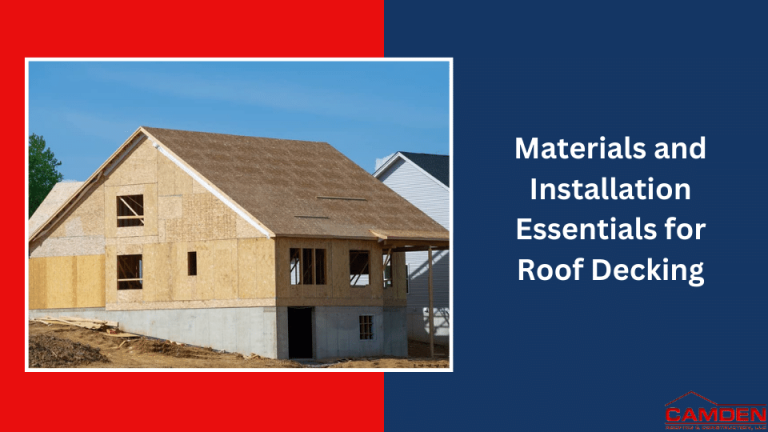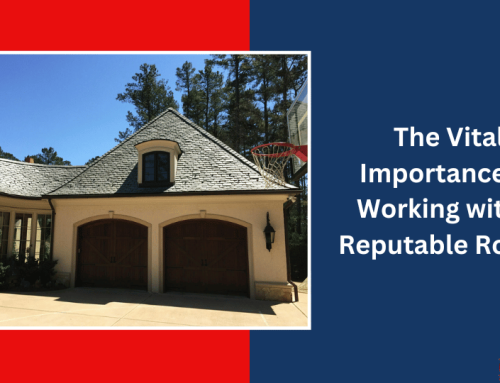Materials and Installation Essentials for Roof Decking from Camden Roofing & Construction. When it comes to roofing, the materials you see on the surface, such as shingles or tiles, often take center stage. However, beneath these visible layers lies a critical component known as roof decking. Roof decking is the solid foundation that supports the roofing materials and provides structural integrity to your roof. Understanding the different materials and installation essentials for roof decking is essential for ensuring a sturdy and reliable roof. In this guide, we’ll explore roof decking materials and the key considerations for proper installation.

Roof Decking Materials
Plywood:
Advantages: Plywood is a commonly used roof decking material due to its strength and versatility. It’s available in various thicknesses, making it suitable for different roofing applications.
Installation: Plywood is typically installed in sheets, and seams are staggered to create a solid, even surface. Proper nailing and fastening are essential to ensure stability and prevent buckling.
Oriented Strand Board (OSB):
Advantages: OSB is another popular choice for roof decking. It’s cost-effective and provides good structural support.
Installation: OSB is installed similarly to plywood, with proper fastening and seam staggering. It’s essential to follow manufacturer guidelines for spacing and nail patterns.
Tongue and Groove Decking:
Advantages: Tongue and groove decking creates a seamless, interlocking surface that enhances the roof’s structural integrity and provides additional insulation.
Installation: Boards are fitted together with the tongue of one board fitting into the groove of the adjacent board. This method creates a solid, even surface.
Wood Planks:
Advantages: Traditional wood planks can be used for roof decking, especially in historic or specialized construction. They offer a unique aesthetic appeal.
Installation: Wood planks are typically installed with proper spacing to allow for expansion and contraction. It’s crucial to use treated or rot-resistant wood to prevent deterioration.
Metal Panels:
Advantages: Metal decking panels are lightweight and durable, making them suitable for commercial and industrial roofing applications.
Installation: Metal decking panels are fastened to the roof’s structural supports and provide a solid substrate for roofing materials.
Installation Essentials
Proper Attachment: Regardless of the decking material chosen, proper attachment to the roof’s structural supports is crucial. The attachment method, including the type of fasteners used and their spacing, should comply with local building codes and manufacturer guidelines.
Ventilation: Adequate roof ventilation is essential to prevent moisture buildup in the attic or under the roof decking. Proper ventilation helps regulate temperature and humidity levels, preventing issues like mold growth and rot.
Underlayment: Roofing underlayment, typically a layer of felt paper or synthetic materials, is installed over the decking before roofing materials. It provides an additional moisture barrier and helps protect the decking from water infiltration.
Flashing: Flashing is crucial around roof penetrations like chimneys, vents, and skylights. Properly installed flashing prevents water from seeping under the roofing materials and damaging the decking.
Roof Slope: The slope of your roof plays a significant role in how water drains away. A proper slope ensures that water flows off the roof and doesn’t pool, preventing water damage and extending the life of the roofing materials and decking.
Inspection: Regular roof inspections are essential to detect any signs of damage or deterioration in the roof decking. Inspections should be conducted at least twice a year, with additional checks after severe weather events.
Maintenance: Maintain the roof decking by keeping it clean and free of debris. Remove leaves, branches, and other debris that can trap moisture and cause deterioration.
Repair or Replacement: If any damage to the roof decking is identified during inspections, it should be promptly repaired or replaced. Ignoring damage can lead to more extensive issues and costly repairs down the line.
Proper Roofing Materials: The choice of roofing materials should complement the type of decking used. Different materials have specific requirements for installation and compatibility with the decking material.
Professional Installation: While some roofing enthusiasts may attempt DIY roofing projects, it’s recommended to hire a professional roofing contractor for roof decking installation. Professionals have the expertise and experience to ensure proper installation and compliance with building codes.
Conclusion
Roof decking may be hidden from view, but it is a fundamental component of your roof’s structural integrity. Choosing the right decking material and following proper installation and maintenance practices are essential for the longevity and performance of your roof. Regular inspections and addressing any issues promptly can help you avoid costly repairs and ensure that your roof continues to protect your home for years to come. When in doubt, consult with a professional roofing contractor who can provide expert guidance and ensure that your roof decking meets the necessary standards.
For more information, contact Camden Roofing & Construction, LLC in Charlotte and Raleigh, NC, at 919-729-5050.

